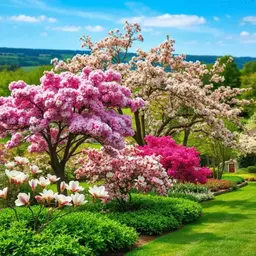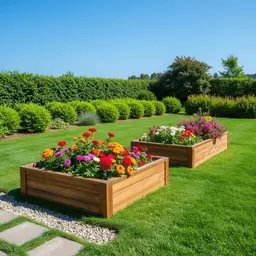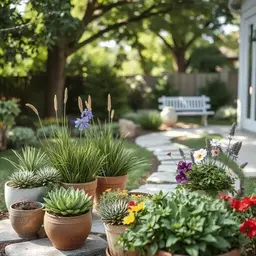Did you know that the timing of your planting can significantly impact the health and beauty of your garden? Understanding seasonal planting for decorative trees is essential for any gardener looking to elevate their outdoor space.
What You Will Learn
- The concept of seasonal planting involves aligning your planting schedule with the natural growth cycles of trees for optimal health.
- Planting trees in the right season can lead to optimal growth, improved soil health, and reduced stress on the trees.
- Decorative trees enhance curb appeal, improve air quality, and provide shade, making them a valuable addition to any garden.
- Incorporating trees into garden design can create focal points and seasonal interest, enriching the overall aesthetic of your outdoor space.
- Key seasonal planting strategies include planting in spring for root establishment, careful watering in summer, and protective measures in winter.
- Ongoing care such as monitoring moisture, applying mulch, and regular pruning is essential for maintaining the health of decorative trees.
- Engaging with local gardening communities can provide valuable support, knowledge, and inspiration for your gardening journey.
Key Seasonal Planting Tips for Decorative Trees
Understanding when to plant and care for decorative trees is crucial for a thriving garden. Below are the essential seasonal insights that ensure optimal growth and health for your trees.
Spring Planting
Ideal time for planting new trees, allowing roots to establish before summer heat.
Summer Care
Focus on watering and pest management to ensure healthy growth.
Fall Planting
Sets trees up for success as they prepare for winter.
Winter Protection
Protect young trees from frost and harsh weather conditions.
Understanding Seasonal Planting for Decorative Trees
When it comes to enhancing your garden, understanding seasonal planting for decorative trees is key. This concept revolves around choosing the right time to plant and care for trees based on the seasons. By aligning your planting schedule with the natural growth cycles of plants, you’re setting yourself up for a thriving garden! You can learn more about specific types of trees in our guide on decorative trees for small gardens.
Seasonal planting is not just about timing; it’s about respecting nature’s rhythms. Trees have specific needs during different times of the year, and being aware of these can make all the difference. Whether you’re a seasoned gardener or just starting out, paying attention to the seasons helps to cultivate a more resilient and beautiful garden.
Defining Seasonal Planting and Its Importance
So, what exactly is seasonal planting? It’s the practice of selecting the right time of year to plant different types of trees based on their growth patterns. This is crucial because planting during the optimal season allows trees to establish their roots more effectively. When trees are planted in the right season, they adapt better to their environment!
Here are a few reasons why seasonal planting is important:
- Optimal Growth: Trees planted at the right time have a better chance of thriving.
- Soil Health: Seasonal timing takes into account soil temperature and moisture levels.
- Reduced Stress: Trees experience less stress when planted in their preferred season.
Key Benefits of Planting Decorative Trees
Decorative trees not only add beauty to your outdoor space but also come with a plethora of benefits. One of the most exciting aspects of incorporating trees into your garden is how they create a welcoming atmosphere. Imagine a vibrant cherry blossom tree greeting you every spring! Just thinking about it makes me smile.
Here are some standout benefits of planting decorative trees:
- Enhanced Curb Appeal: Trees can significantly boost the visual appeal of your home.
- Environmental Benefits: Trees improve air quality and support local wildlife.
- Shade and Cooling: They provide shade, reducing energy costs during hot months.
Incorporating Garden Design with Decorative Trees
Integrating decorative trees into your garden design is an art that can transform any space. Think about how trees can serve as focal points or frame different areas of your garden. For instance, a graceful weeping willow can create a serene corner by your pond, inviting peaceful moments of reflection. For more ideas on how trees can boost your home's exterior, check out our article on enhancing curb appeal with trees.
Here are some tips for incorporating decorative trees into your garden design:
- Consider Height and Spread: Choose trees that fit the space you have available.
- Mix and Match: Combine various species for a dynamic visual effect.
- Plan for Seasonal Changes: Select trees that offer year-round interest, like spring flowers and autumn colors.
By thoughtfully incorporating trees, you’re not just planting; you’re creating a living masterpiece that reflects your personal style. At Garden Plan Guide, we’re here to help you with every step of your gardening journey!
Pro Tip
Did you know? Planting in the early morning or late afternoon can significantly improve your tree's establishment. During these times, temperatures are cooler, reducing stress on the plants and allowing for better water absorption. This simple adjustment to your planting schedule can lead to healthier, more resilient trees!
Summarizing Key Seasonal Planting Insights
As we wrap up our discussion on seasonal planting for decorative trees, it’s essential to remember the key tips that can help your garden thrive throughout the year. From understanding the best times to plant to knowing how to care for your trees, these insights provide a solid foundation for any gardening enthusiast. It’s amazing how a little planning can lead to stunning results in your outdoor space!
First, let’s recap some important seasonal planting tips:
- **Spring** is the ideal time to plant new trees, allowing roots to establish before the heat of summer.
- During **summer**, focus on watering and pest management to ensure healthy growth.
- **Fall** planting can set your trees up for success, preparing them for the winter ahead.
- In **winter**, protect young trees from frost and harsh weather conditions.
By keeping these tips in mind, you'll be well-equipped to create a beautiful and resilient garden landscape.
Importance of Ongoing Tree Care and Maintenance
Even after planting, ongoing care is vital for the health and longevity of your decorative trees. Just like us, they need attention and care to flourish! Regular watering, proper fertilization, and timely pest management are crucial components of maintaining vibrant trees. For more tips on general plant care, consider reading about low-maintenance plants for gardens.
Consider these ongoing care strategies:
- Monitor moisture levels to ensure trees are adequately watered.
- Apply mulch to retain moisture and regulate soil temperature.
- Regularly check for signs of pests or disease and act promptly.
- Prune trees as needed to promote healthy growth and shape.
At Garden Plan Guide, I believe that an informed gardener is an empowered gardener. By understanding the ongoing needs of your decorative trees, you can create a thriving garden that brings joy for years to come!
Frequently Asked Questions (FAQs)
- Q1: What is seasonal planting for decorative trees?
- A1: Seasonal planting involves choosing the optimal time of year to plant and care for trees, aligning with their natural growth cycles to promote better establishment, health, and resilience.
- Q2: Why is seasonal planting important for trees?
- A2: It's important because planting trees in their preferred season reduces stress, allows for better root establishment, and takes advantage of ideal soil temperatures and moisture levels, leading to optimal growth and a higher survival rate.
- Q3: What are the best seasons for planting new trees?
- A3: Spring is ideal for planting new trees, as it allows roots to establish before summer heat. Fall planting is also beneficial, preparing trees for winter and encouraging root growth before the ground freezes.
- Q4: What are the key benefits of planting decorative trees in a garden?
- A4: Decorative trees enhance curb appeal, improve air quality, support local wildlife, and provide shade, which can reduce energy costs. They also add aesthetic value and create focal points in garden design.
- Q5: What ongoing care do decorative trees need after planting?
- A5: Ongoing care includes monitoring moisture levels and adequate watering, applying mulch to retain moisture, regularly checking for pests or diseases, and pruning as needed to promote healthy growth and shape.
Call to Action: Enhancing Your Gardening Knowledge
Now that we’ve covered the essentials of seasonal planting and care for decorative trees, it’s time to deepen your gardening knowledge. There are so many resources out there to help you along your journey! Whether you're a seasoned gardener or just starting, continuous learning is key to success. You might also find valuable insights in our beginners guide to garden layout.
Here are a few ways to enhance your understanding:
- Explore additional resources on tree care through books, blogs, and online courses.
- Engage with local gardening communities, where you can share tips and experiences!
- Attend workshops or gardening events for hands-on learning opportunities.
By connecting with others who share your passion, you can gather valuable insights and inspiration. If you have any landscaping ideas or strategies you’d like to share, feel free to comment below or reach out to me directly at Garden Plan Guide. Let’s keep the conversation going and help each other cultivate beautiful gardens!
Engaging with Local Gardening Communities for Support
Being part of a community can significantly enhance your gardening experience! Local gardening groups often provide a wealth of knowledge, support, and encouragement. You can learn so much from fellow gardeners who have faced similar challenges and triumphs. For great advice on choosing plants that truly make your home stand out, take a look at plants that boost curb appeal.
Consider these ways to engage with your community:
- Join a local gardening club to meet like-minded individuals.
- Participate in community gardening projects or events.
- Visit local nurseries and participate in workshops they may offer.
Gardening is not just about plants; it's also about the connections we make along the way. Embrace the community spirit, and let’s grow together!
Recap of Key Points
Here is a quick recap of the important points discussed in the article:
- Seasonal planting aligns with the natural growth cycles of trees, enhancing their establishment and resilience.
- Planting in spring allows roots to establish, while fall planting prepares trees for winter.
- Ongoing care is essential, including regular watering, mulching, and pest management.
- Incorporate decorative trees into garden design by considering their height, spread, and seasonal interest.
- Engaging with local gardening communities can provide support, knowledge, and inspiration.










